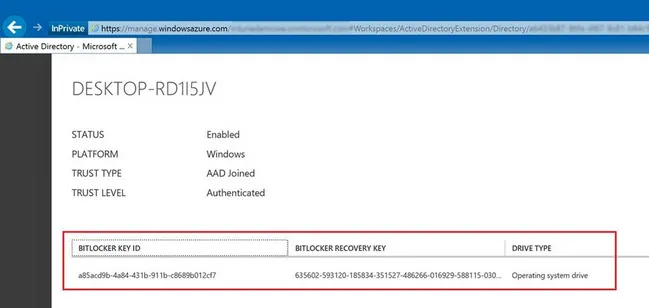Generate Bitlocker Key From Id
Faculty and staff can unlock their encrypted computer using the MBAM self-service portal. If the client detects conditions that suggest improper access (e.g., incorrect password entered or operating system files or BIOS were changed), it puts the computer into a recovery mode that requires a key to unlock.
- BitLocker uses domain authentication to unlock data volumes. Operating system volumes cannot use this type of key protector. Any of these protectors encrypt a BitLocker Volume Master Key (VMK) to generate a Full Volume Encryption Key (FVEK), which is then used to encrypt the volume. Using Memory Images for Instant Decryption of BitLocker.
- I make a password on my two drive with bitlocker and save the keys on my microsoft account. And now I forget the password and when I went to my account I just find the one keys on my account. Two of my drive have same password. Now I can open one of my drive. If I find the password of my account that have the key I can open the other drive.
- If there are multiple accounts, you can use the “Key ID” displayed on the BitLocker screen on the computer and match it to the Key ID that appears on the web page. That will help you find the correct key.
MBAM (Microsoft BitLocker Administration and Monitoring) provides enterprise management capabilities for Bitlocker, Microsoft disk encryption technology that protects data against unauthorized access if a computer is lost or stolen.
This error can occur from the following:
You must provide the first 8 characters of the recovery key ID. The admin can use it to search for your BitLocker recovery key in the Azure Active Directory Admin Center. As you can see from the example screenshot below, the admin can find the BitLocker recovery key associated with the user’s account and device.
- Power outage
- Unexpected restart
- Windows Updates
- Hardware issues
- Replacement hardware
- BIOS changes
Most of the time, this issue is easily fixed by pulling a recovery key.
- Record the first 8 characters of your key ID.
- Navigate to the UConn Bitlocker page.
- Log in with your NetID.
- Enter the first 8 characters of your key.
- Select a reason from the drop-down menu.
- Select Get Key to generate a 48-digit numeric key.
- On the Bitlocker recovery screen on your computer, enter the numeric key into the Enter the recovery key for this drive field.
Click Enter.
You may need to wait as the computer unlocks.
Related Articles
To manage BitLocker from an elevated command prompt or from a remote computer, use theManage-bde.exe tool. The following example demonstrates how to view the status.
Run the following command to enable BitLocker on the C drive, store the recovery key onthe Y drive, and generate a random recovery password.

After you run the command, restart the computer with the recovery key connected to completethe hardware test. After the computer restarts, BitLocker will begin encrypting the disk.

Run the following command to disable BitLocker on the C drive.

You can also use the Manage-bde.exe script to specify a startup key and a recovery key,which can allow a single key to be used on multiple computers. This is useful if a singleuser has multiple computers, such as a user with both a Tablet PC computer and a desktopcomputer. It can also be useful in lab environments, where several users might share severaldifferent computers. Note, however, that a single compromised startup key or recovery keywill require all computers with the same key to be rekeyed.
Generate Bitlocker Recovery Key From Key Id
For detailed information about using Manage-bde.exe, run manage-bde.exe -? from acommand prompt.